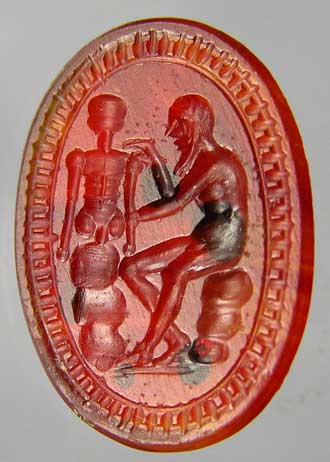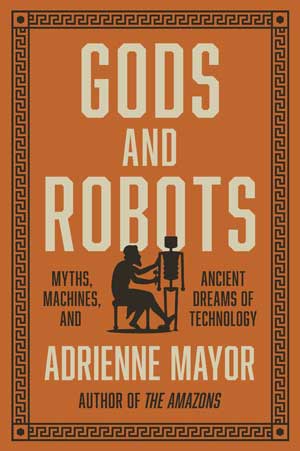
Who first imagined robots?
Most historians believe that automatons were first developed in the Middle Ages. Some philosophers of science claim that it was impossible for anyone in ancient times to imagine technologies beyond what already existed. Other scholars assume that all animated beings in mythology were inert matter brought to life by gods or magic, like Adam or Pygmalion’s ivory statue. But I wondered, Was it possible that the concepts of robots could have been imagined in classical antiquity?
I found that people were describing imaginary automatons as early as Homer, more than 2,500 years ago. A remarkable group of Greek myths envisioned ways of replicating nature by bio-techne, “life through craft.” Robots, synthetic beings, and self-moving devices appear in myths about Odysseus, Jason and the Argonauts, the sorceress Medea, the bronze automaton Talos, the brilliant craftsman Daedalus, the fire-bringer Prometheus, and Pandora, the female android fabricated by Hephaestus, god of invention. Hephaestus, Homer tells us, made many wonders: automatic gates to the heavens, “smart” bellows for his forge, driverless carts to serve ambrosia at celestial banquets, and a staff of Golden Maidens endowed with movement, mind, and all the knowledge of the gods.
Ancient poets described Talos, Pandora, and other lifelike artificial entities as “made, not born.” This crucial phrase calls out their technological, non-biological origins. And it distinguishes them from things magically given life. These marvels were constructed using the same tools, materials, and methods that human artisans used, but with awesome results. Hesiod (ca 700 BC) even detailed the inner workings and power source of the bronze Talos, fulfilling modern definitions of “robot.”
So, thousands of years before medieval and early modern machines, and even centuries before technological innovations of antiquity made self-moving devices possible, ideas about creating artificial life were being explored in Greek myth. These imaginative tales were ancient thought experiments, set in an alternate world where technology was marvelously advanced. Gods and Robots is the first book to survey the ancient origins of the desire to create artificial life, drawing on narratives and art from the age of mythology to the proliferation of real automatons in the Hellenistic era (fourth century to first century BC).
Of course, it’s important to keep in mind that much of ancient literature and art has vanished or is incomplete. This sad fact determines one’s path of discovery and interpretation. We travel across a landscape ravaged by time—something like the “mosaic effect” after devastating wildfires. In other words, readers should not expect a simple linear route in these chapters. Instead, like Theseus following a thread to navigate the Labyrinth designed by Daedalus—and like Daedalus’s little ant making its way through a convoluted seashell to its reward of honey—we follow a meandering, backtracking, braided trail of stories and images. One can dip into the chapters in any order. Mythology is a great tapestry with myriad threads, interwoven and looping back to familiar characters and stories. We are bound to accumulate new insights as we go.
As a folklorist and historian of ancient science, I investigate the crossroads of classical antiquity, literature and art, archaeology, and history. My goal is uncovering historical and scientific realities embedded in mythology, legends, and popular natural knowledge. You could say I’m a historian of human curiosity, seeking the first inklings of the scientific impulse in pre-modern cultures.
Since 2006, I’ve lived in Silicon Valley, California, surrounded by constant innovations in robotics and Artificial Intelligence (AI) and other techno-advances. Here one is very aware of the drive to create artificial life, from robots and AI, to surpassing nature, enhancing human powers, and striving for longevity and even immortality. It seemed natural to investigate how deep the roots of such endeavors and desires really are.
Inviting readers to time-travel more than two millennia, to contemplate what are essentially the first science fiction tales told by a pre-industrial society? That may seem ironic as we rush headlong into the future. But I think the sophistication—and the startling relevance—of these ancient dreams of technology might help us understand the timeless link between imagination and science. Humans have been pondering artificial life for ages.
Some imaginary self-propelled devices and androids in the myths foreshadow some of today’s technological inventions of driverless cars, automated machines, and humanoid automatons. There are mythic versions of AI and ancient parallels to the modern “Uncanny Valley” effect—that eerie sensation we have when encountering hyper-realistic robots. Some of the doubt and trepidation about creating artificial life expressed in antiquity anticipate our own practical and ethical dilemmas about AI and playing god by improving on nature.
One fear today is that technology favors tyranny. That notion has ancient roots. In the myths, the autonomous contraptions and robots that Hephaestus made for the gods on Mount Olympus are charming, benign. But when automatons are sent to earth and interact with humans, mayhem and tragedy ensue. The myths seem to caution that such things are marvelous to imagine on an abstract plane but can wreak havoc in the real world. Moreover, in the myths, it’s tyrants like Zeus who deploy deadly automatons against mortals. Indeed, autocrats’ interest in technology continued in historical times, with tyrannical rulers commissioning novel mechanical weaponry for war and machines of malice to torture and kill. Other autocrats, such as Ptolemy Philadelphus of Alexandria, displayed fabulous monumental automatons to demonstrate their wealth and power.
Gods and Robots focuses on mythology and historical inventions in the Greek-influenced world. But the ancient Greeks were not unique in imagining and constructing self-moving devices and animated machines. I include examples from Egypt, Persia, India, and China that show similar ingenuity and innovations in imagining and making artificial life. One of my favorite non-Greek legends tells how Buddha’s bodily relics were guarded for two hundred years by robot warriors, constructed from plans smuggled to India from the Mediterranean world.
I picture someone in a bookstore becoming intrigued by the 75 illustrations, especially the 14 color plates showing the stunning skills of fifth-century BC artists. Ancient coins depict the bronze guardian Talos defending Crete from invaders, hurling rocks to sink ships. On a bronze mirror, he hugs victims against his red-hot chest. In vase paintings, Talos reels back and collapses as Medea and Jason destroy him. One vase painter humanized the dying Talos by dabbing a teardrop on his bronze cheek. Another scene shows Jason using a tool to remove the crucial bolt that seals the killer robot’s power source. His vital fluid, ichor, flowed out like molten lead.
Other vase paintings show the gods preparing the replicant maiden Pandora for her baleful mission on earth. She stands stiffly like a wind-up doll with an eerily vacuous smile. Paging through the chapter “Pandora: Beautiful, Artificial, Evil,” one quickly learns that the sentimental fairytale version of Pandora has nothing to do with the original Greek myth. A vengeful Zeus ordered Hephaestus to make an “evil trap disguised as beauty”—in the form of a ravishing young woman—to punish humankind for accepting the gift of stolen fire. Pandora was created to carry out one task. She opened the jar of misfortune and suffering that would plague mortals forever.
Also eye-catching are the images of Prometheus using tools to build the first human from scratch, starting with the skeleton, carved in exquisite detail on tiny gems.
Another browser’s attention might be captured by Homer’s description of a fantastic fleet of self-navigating ships in the Odyssey. Visiting the Phaeacians, a mysteriously advanced city ruled by King Alcinous, Odysseus explains his heart’s desire to return to his home island after ten years of wandering. The king offers a voyage on one of his ships. The vessels sail on their own, with no captain and no rowers. Endowed with navigation maps of the known world, they need only to hear the destination to plot the route. Sailing to Ithaca, Odysseus marvels at the ship’s cruising speed of falcons, cutting through all weather and sea conditions. The imaginary Phaeacian ships, with access to vast data archives and charts, prefigure advanced GPS systems.
From time to time, I include references to modern sci-fi films that resonate with the classical myths, such as Metropolis (1927), Frankenstein (1931), Jason and the Argonauts (1963), Blade Runner (1982 and 2017) and TV shows such as Westworld. The mythic tales are certainly cinematic! The age-old myths and modern movies about imagined technology are cultural dreams. Both show the power of imagination, allowing humans to think about how artificial life might be created—if only one possessed sublime technology and genius. And like our futuristic, often dystopic tales, the myths warn of the consequences of creating artificial life.

In historical antiquity, animated devices were actually built, culminating in a host of automatons in the great center of imagination and invention, Alexandria, Egypt. The last chapter of my book surveys real, historical inventions of engineering marvels. Ctesibius, Philo, Heron, and others designed android servants that poured wine, singing birds, moving figures of dragons and serpents, and colossal animated statues. The first model of a bird that could fly was invented by the Greek engineer and politician Archytas, who was a friend of Plato in the fourth century BC. Did “science fiction” myths about self-moving devices inspire the real craftsmen who began to produce wonders of technology? Many of their machines alluded to mythological figures.
Gods and Robots presents a wide range of forms of artificial life in mythology, quests for a longer, even eternal life, superhuman powers borrowed from gods and animals, and automatons and lifelike replicants. The imaginary marvels are not exactly machines, robots, or AI in the modern sense, of course. My book is not intended to suggest direct lines of influence from myth or ancient history to modern technology. Yet the resonances with modern science and popular culture are striking, making the myths as “good to think with” now as they were then.
Sophocles wrote tragedies featuring both Talos and Pandora, now lost. But his paean to human ingenuity survives. Praising the audacious creative powers of men and women in contriving ways to escape and imitate the forces of nature, the playwright noted that the outcomes could be for good or evil. Notably, Aristotle referred to the labor-saving automatons created by Hephaestus in his discussion of slavery. Millennia ago, musings on artificial life were already raising questions of free will, slavery, the origins of evil, natural limits, and what it means to be human. I hope my book might enrich our understanding that imagination has always been the spark that ignites science.


Adrienne Mayor is a research scholar in the Classics Department and History and Philosophy of Science Program, Stanford University. In 2018-19, she was a Berggruen Fellow, Center for Advanced Study in the Behavioral Sciences. She is the author of The Amazons: Lives and Legends of Warrior Women across the Ancient World; The First Fossil Hunters; Fossil Legends of the First Americans; Greek Fire, Poison Arrows, and Scorpion Bombs: Biological and Chemical Weapons in the Ancient World; a biography of Mithradates, The Poison King (National Book Award nonfiction finalist); and Gods and Robots.